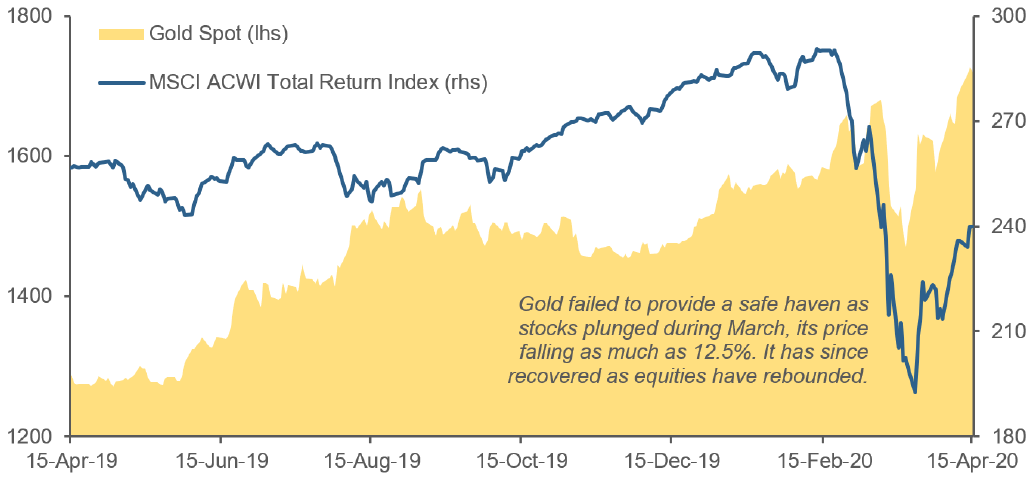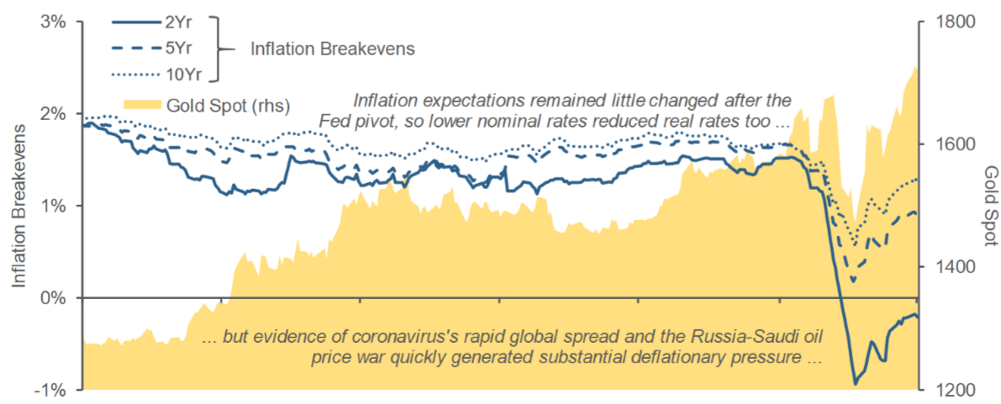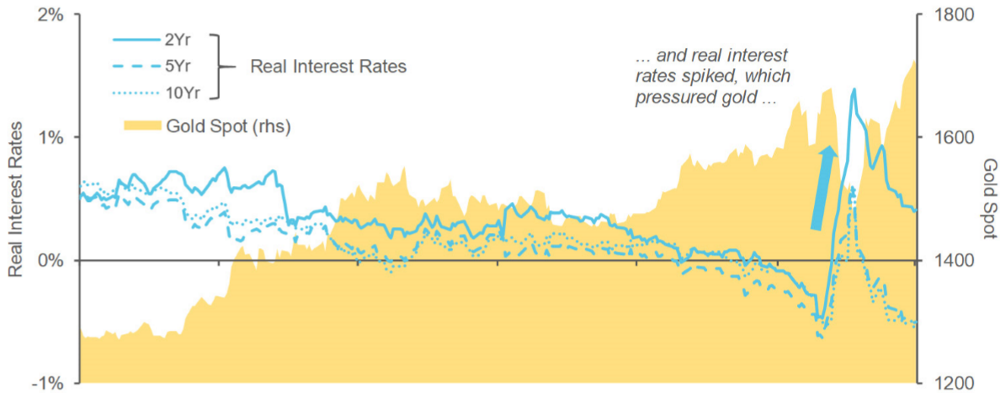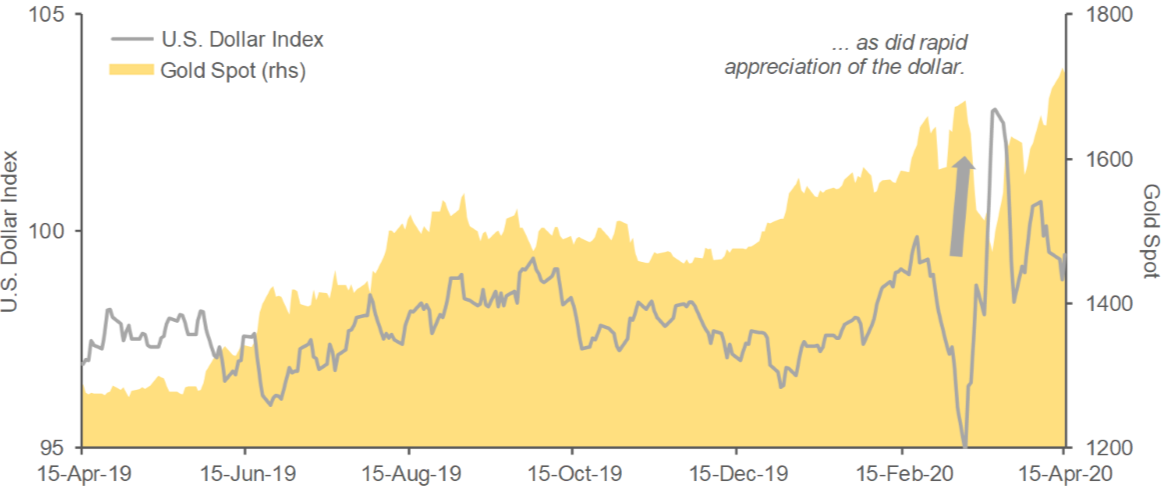Gold in Crisis?
Key Takeaways
- Despite gold’s reputation as a safe haven, it does not always deliver on that expectation.
- Gold’s price is influenced by macroeconomic factors, especially nominal interest rates, inflation expectations, and the U.S. dollar.
- The interplay between these factors helps to explain gold’s surprising performance in the COVID crisis and offers a framework to understand why gold’s behavior might deviate from conventional wisdom in other circumstances.
Table of contents
April 2020
The surprisingly procyclical behavior of gold prices during the coronavirus crisis has renewed scrutiny of its widely perceived safe-haven status. In March, as stocks were suffering one of their most violent selloffs in the past century, the price of gold dropped $200, as much as 12% (Figure 1). It subsequently rallied back to multi-year highs as equities rebounded.
Various narratives surfaced to explain the drop in gold during an episode in which many investors would have expected and greatly valued protection, including forced selling driven by margin calls and profit taking. In our view, however, those explanations largely miss the mark. Instead, gold’s recent performance is a reminder that the commodity’s safe-haven qualities during market stress (and its behavior more generally) depend on the particulars of the macroeconomic environment, especially real interest rates and the U.S. dollar, the currency in which gold is denominated.
Gold and the Macro Environment
Revisiting a few of gold’s salient characteristics helps to clarify its behavior during the COVID crisis: it has essentially zero productive value and generates no income, but it is also scarce, durable, and portable. Those properties explain why gold has long been viewed as a good store of value, with expected returns that bear some relationship to inflation expectations. As a result, its price is directly influenced by real returns available on other assets, including “safe” sovereign bonds, e.g., U.S. Treasuries.
Figure 1: Gold and Equities – Co-moving in the COVID Crisis

Sources: Acadian Asset Management LLC, Bloomberg. Index source: MSCI Copyright MSCI 2020. All Rights Reserved. Unpublished. PROPRIETARY TO MSCI. It is not possible to invest directly in an index. For illustrative purposes only. Investors have the opportunity for losses as well as profits. Past performance is no guarantee of future results.
Figure 2: Gold Prices, Inflation Expectations, Real Interest Rates, and the Dollar



Inflation breakevens calculated based on U.S. Treasuries. Sources: Acadian Asset Management LLC, Bloomberg. For illustrative purposes only. Investors have the opportunity for losses as well as profits. Past performance is no guarantee of future results. It is not possible to invest directly in an index.
In 2019 and the first part of 2020, declining real interest rates helped to push up gold prices. In 2019, nominal Treasury yields fell as the U.S. Federal Reserve pivoted back towards easing to stimulate a softening economy and offset trade tensions. Inflation expectations remained stable, so real interest rates drifted lower (Figure 2, top two charts). This decline in real yields accelerated in the first two months of 2020 amid brewing concerns about COVID’s impact on Chinese supply chains and global growth and expectations of further rate cuts. Figure 2 shows that by February, real rates on U.S. Treasuries were negative for maturities between 2 and 10 years. By early March, gold’s price had risen 30% relative to mid-2019 levels.
But as the COVID crisis escalated and global equity markets plunged, real yields spiked. This reflected an abrupt collapse of inflationary expectations that more than offset the Fed’s rapid reduction of its target rate from 1.5% to zero. In fact, Figure 2 shows that the TIPS market briefly priced in nearly 1% deflation. The sharp drop in gold prices is consistent with Treasuries suddenly offering a comparatively attractive real yielding investment, and a rapid strengthening of the dollar added to the pressure (Figure 2, bottom chart).
A macro environment conducive for gold would be one with falling nominal rates, rising inflation expectations, and a weakening dollar. During the acute March equity selloff, only the first of these conditions prevailed, and gold fell sharply. Since then, however, gold has risen to multi-year highs as inflationary expectations have rebounded while nominal rates have remained subdued and the dollar has partially reversed its sharp appreciation. Figure 3 contrasts macro conditions in terms of their favorability for gold between the violent equity selloff and the subsequent rebound.
Figure 3: Favorability of Macro Conditions with Respect to Gold Prices

Source: Acadian Asset Management LLC. For illustrative purposes only.
Conclusion
While many investors view gold as a reliable safe haven in times of crisis, it has not always delivered on that expectation. The price of gold is influenced by macroeconomic and policy-driven factors, which must be considered in order to have a coherent picture of its behavior in relation to other assets. The interplay between nominal interest rates, inflation expectations, and the U.S. dollar helps to explain gold’s performance in the COVID crisis and offers a framework to understand why gold’s behavior might deviate from conventional wisdom in other circumstances.
Legal Disclaimer
These materials provided herein may contain material, non-public information within the meaning of the United States Federal Securities Laws with respect to Acadian Asset Management LLC, Acadian Asset Management Inc. and/or their respective subsidiaries and affiliated entities. The recipient of these materials agrees that it will not use any confidential information that may be contained herein to execute or recommend transactions in securities. The recipient further acknowledges that it is aware that United States Federal and State securities laws prohibit any person or entity who has material, non-public information about a publicly-traded company from purchasing or selling securities of such company, or from communicating such information to any other person or entity under circumstances in which it is reasonably foreseeable that such person or entity is likely to sell or purchase such securities.
Acadian provides this material as a general overview of the firm, our processes and our investment capabilities. It has been provided for informational purposes only. It does not constitute or form part of any offer to issue or sell, or any solicitation of any offer to subscribe or to purchase, shares, units or other interests in investments that may be referred to herein and must not be construed as investment or financial product advice. Acadian has not considered any reader's financial situation, objective or needs in providing the relevant information.
The value of investments may fall as well as rise and you may not get back your original investment. Past performance is not necessarily a guide to future performance or returns. Acadian has taken all reasonable care to ensure that the information contained in this material is accurate at the time of its distribution, no representation or warranty, express or implied, is made as to the accuracy, reliability or completeness of such information.
This material contains privileged and confidential information and is intended only for the recipient/s. Any distribution, reproduction or other use of this presentation by recipients is strictly prohibited. If you are not the intended recipient and this presentation has been sent or passed on to you in error, please contact us immediately. Confidentiality and privilege are not lost by this presentation having been sent or passed on to you in error.
Acadian’s quantitative investment process is supported by extensive proprietary computer code. Acadian’s researchers, software developers, and IT teams follow a structured design, development, testing, change control, and review processes during the development of its systems and the implementation within our investment process. These controls and their effectiveness are subject to regular internal reviews, at least annual independent review by our SOC1 auditor. However, despite these extensive controls it is possible that errors may occur in coding and within the investment process, as is the case with any complex software or data-driven model, and no guarantee or warranty can be provided that any quantitative investment model is completely free of errors. Any such errors could have a negative impact on investment results. We have in place control systems and processes which are intended to identify in a timely manner any such errors which would have a material impact on the investment process.
Acadian Asset Management LLC has wholly owned affiliates located in London, Singapore, and Sydney. Pursuant to the terms of service level agreements with each affiliate, employees of Acadian Asset Management LLC may provide certain services on behalf of each affiliate and employees of each affiliate may provide certain administrative services, including marketing and client service, on behalf of Acadian Asset Management LLC.
Acadian Asset Management LLC is registered as an investment adviser with the U.S. Securities and Exchange Commission. Registration of an investment adviser does not imply any level of skill or training.
Acadian Asset Management (Singapore) Pte Ltd, (Registration Number: 199902125D) is licensed by the Monetary Authority of Singapore. It is also registered as an investment adviser with the U.S. Securities and Exchange Commission.
Acadian Asset Management (Australia) Limited (ABN 41 114 200 127) is the holder of Australian financial services license number 291872 ("AFSL"). It is also registered as an investment adviser with the U.S. Securities and Exchange Commission. Under the terms of its AFSL, Acadian Asset Management (Australia) Limited is limited to providing the financial services under its license to wholesale clients only. This marketing material is not to be provided to retail clients.
Acadian Asset Management (UK) Limited is authorized and regulated by the Financial Conduct Authority ('the FCA') and is a limited liability company incorporated in England and Wales with company number 05644066. Acadian Asset Management (UK) Limited will only make this material available to Professional Clients and Eligible Counterparties as defined by the FCA under the Markets in Financial Instruments Directive, or to Qualified Investors in Switzerland as defined in the Collective Investment Schemes Act, as applicable.
Don't miss the next Acadian Insight
Get our latest thought leadership delivered to your inbox